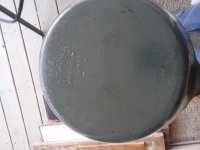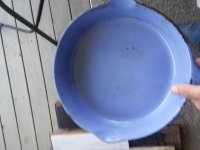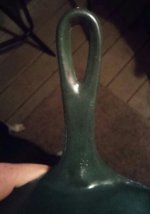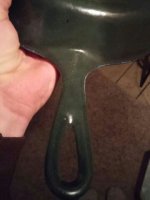-
If a web search for the answer to your cast iron cookware question has brought you directly to this forum, the information you seek may be covered in one of the many reference topics featured on the main website.
Quick Links: · Main Website · How to Identify Unmarked Pans · All About Cleaning & Seasoning · Reproductions & Counterfeits · Commonly-Used Terms
You are using an out of date browser. It may not display this or other websites correctly.
You should upgrade or use an alternative browser.
You should upgrade or use an alternative browser.
Enameled Wagner?
- Thread starter DaleR
- Start date
Wagner produced speckled enameled ashtrays. Enameled skillets are known, but it's uncertain Wagner themselves made them, or if they did whether they were regular production items. They're certainly not mentioned or shown in any of the catalogs I have seen. Only enameled on the inside is unlike any of the others which are enameled inside and out, and in both solid and speckled colors.
Sharon Shuman
Member
Thanks for showing this Dale. The #8 skillet we've used for years is a white on black speckle, with nothing showing but the 8 on the handle. I have long thought it to be a Wagner, particularly due to the handle shape. I have 2 ashtrays in red and red-orange speckle on black on which the Wagner markings are visible. The similarity of speckle pattern is very distinctive. The pan Dale shows here is one I haven't seen before, so thanks again for the sharing!
There has been earlier discussions regarding enamel pieces and some theories were that most pieces were sent out to a third party for the enamel process. I have a couple skillets that are believed to be BSR but the underside of the handle has been grooved which is not typical of BSR. Some believe that they were grooved to remove sharp edges thus less chipping of the enamel.
So...With all that said I was just curious to see if your piece had a grooved out section of the underside of the handle. My after thought is that Wagner handles were more rounded than the BSR's so it probably would not have been implemented on WW pieces.
Thanks for the pic's.
So...With all that said I was just curious to see if your piece had a grooved out section of the underside of the handle. My after thought is that Wagner handles were more rounded than the BSR's so it probably would not have been implemented on WW pieces.
Thanks for the pic's.
I've seen extensive discussions on the BSR enameled pieces and whether they had been done 3rd party. I wonder here, with the Wagner, if anybody else has encountered these. If a 3rd party had taken to doing these I'd think there would be quite a few examples (as there are with the BSR's). I know Wagner did SOME enamel pieces ie. chef skillet and ashtrays. Wonder if the dabbled in doing some of the pans in response to the Griswold (and others) line of enamel ware.
Sharon Shuman
Member
Dale's pan is an interesting piece. The markings on the bottom are obviously Wagner, but the handle looks like Griswold. Then there is the enameling, which is certainly not commonplace. We REALLY need a crystal ball here; when was this pan made, and where? I know, it's marked Sidney O; but it was probably enameled somewhere else. I wish this piece of CI could talk to us; I would like to know it's history!
The only handles I can think of that can be considered distinctively Griswold are the scoop handle of the 1st series Erie and the late grooved handle of the last of their skillets. This handle is one of a couple of regular Wagner designs, albeit coated in enamel.
Sharon Shuman
Member
I won't argue with you on this, Doug. The similarities, as opposed to differences, of older American CI can be too interesting sometimes.
As interesting as this piece has become....I am wondering how many pieces of CI made their way out of foundries as gifts to the workers? I have an Aunt that worked all her life at Owens & Illinois Mfg. and she brought home endless pieces that were off spec,/over-runs and some that the workers made just to keep busy.
I tend to think that the CI manufactures around the turn of the century and well into the fifties probably brought home some of their work (legal or illegally) that have found their way into the main stream but not privy to the public for purchase.
It could be that there was a batch of these skillets produced and given to the workers for their wives or family to use and see what they thought of them. I am just guessing of course but maybe the test results were not as good as Wagner wanted and therefore never did produce any for sale to the public. If they were catalogued I certainly can not find anything.
I would hang on to it and you can always brag that you have something that no one else may have.
I tend to think that the CI manufactures around the turn of the century and well into the fifties probably brought home some of their work (legal or illegally) that have found their way into the main stream but not privy to the public for purchase.
It could be that there was a batch of these skillets produced and given to the workers for their wives or family to use and see what they thought of them. I am just guessing of course but maybe the test results were not as good as Wagner wanted and therefore never did produce any for sale to the public. If they were catalogued I certainly can not find anything.
I would hang on to it and you can always brag that you have something that no one else may have.
As interesting as this piece has become....I am wondering how many pieces of CI made their way out of foundries as gifts to the workers? I have an Aunt that worked all her life at Owens & Illinois Mfg. and she brought home endless pieces that were off spec,/over-runs and some that the workers made just to keep busy.
I tend to think that the CI manufactures around the turn of the century and well into the fifties probably brought home some of their work (legal or illegally) that have found their way into the main stream but not privy to the public for purchase.
I hadn't thought of that before. Good theory. When I was at the Lodge factory store, there were tons of pieces in the "defect" section that looked perfectly fine to me.
I saw a term yesterday I was not familiar with. A guy selling a skillet on Etsy referred to a rough spot of the bottom of a skillet as a "buttered" logo. One of my new skillets also has a spot where it looks like they covered up a logo (maybe a Lodge arc?) with iron. I wonder if these were defective skillets they didn't want their name on ... or the logo itself didn't turn out right, so they covered up the mistake?
http://www.castironcollector.com/forum/archive/index.php/t-1303.html
This thread talks about "buttering" on a skillet.
This thread talks about "buttering" on a skillet.
The artifact of pattern alteration known as buttering could be a maker changing markings on its own patterns or a maker using a competitor's pan as the basis for a pattern covering the existing markings. Recasts typically don't bother to try to hide original markings.




